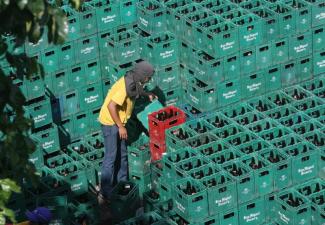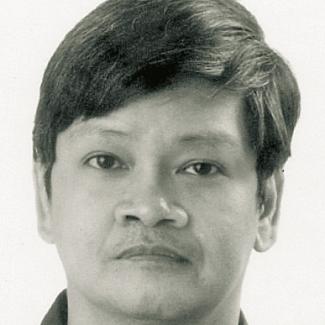Beverage industry
A poor nation’s beer conquers the world

In 1890, when the Philippines was still a colony of Spain, businessman Enrique Barretto used a royal permit to open a brewery in Manila. He called it “La Fabrica de Cerveza de San Miguel” (San Miguel Brewery) after the capital’s district it was sited in. Then he hired a German brew master to formulate a pils beer. Invited to taste the product, a city official conjured the firm’s success by saying: “May the gold flow each time the beer taps are opened.”
His blessing was amply fulfilled. From a first year output of 500 barrels, the brewery grew fast: the market couldn’t get enough of the pale pils beer. Through years of turmoil – the revolution, the collapse of the Spanish regime, the invasion and takeover of the Philippines by the Americans – San Miguel grew further. The beer was so popular that it was being exported to Hong Kong, Shanghai and Guam as early as 1914.
This growth was interrupted by the Second World War, when invading Japanese seized the company and renamed it “Balintawak Beer Brewery”. But after the war, San Miguel reacquired its name, resumed its dominance of the Philippine market and started expanding overseas once more.
In a period when products from the industrialised west were flooding the markets of developing nations, San Miguel headed the other way: in 1948 the company set up a brewery in Hong Kong. A few years later, two Spanish businessmen sailed from Europe to Manila on a mission of persuasion. The result was the “Manila Agreement”, under which San Miguel granted the Spanish firm La Segarra the license to bring the beer and its brand to Spain.
San Miguel, for its part, slowly expanded into Asia, opening breweries in China, Vietnam, Thailand and Indonesia. It currently exports its beer to 40 countries around the world, including Europe. The independent Spanish licensee, now called Mahou San Miguel, continues to use the San Miguel brand name and a logo similar to the original. As a result, two different tasting beers are sold in Europe under the same brand name. Indeed, the “San Miguel beer” made in Spain in no way resembles the original Manila pils – which is said to taste much better. In an interesting development, the two companies signed a “cooperation agreement” last year in order to “unify the brand”. No details were given though on how this would be done.
Here in the Philippines, San Miguel continues to dominate the beer market: In 2012, its share was 90 %. Anyone who asks for a beer in this country will be, by default, served a San Miguel product. But the name now means more than just beer. Even Barretto could not foresee what his brewery – and accompanying ice plant – would become. San Miguel Corporation (SMC), as it is now called, is a gigantic conglomerate. With revenues in 2013 coming to $ 17.6 billion and total assets valued at $ 27.5 billion, it is the Philippines’ biggest company and among the Forbes list of the world’s 2000 biggest stock-market listed companies.
Expansion strategy
During the 20th century, San Miguel grew by expanding into related industries, buying companies that made soda, ice cream, hard liquor, processed meat, flour and packaging. These turned the conglomerate into Southeast Asia’s largest food, beverage and packaging company. But in the 21st century, SMC realised it had a problem that ironically stemmed from its very strength. When you have a virtual monopoly of the Philippine beer market, how else can you grow? The number of beer drinkers is naturally limited.
SMC’s answer: expand into other businesses. In 2008, it diversified into mining, banking, fuel and oil, power generation, infrastructure and even – for a while – the airline business. Now it’s about to go into telecommunications in partnership with Telstra. According to Jonathan Ravelas, a leading analyst with the Philippines’ largest bank BDO Unibank, about half of every peso a Filipino spends currently flows directly or indirectly into the coffers of San Miguel.
Ramon Ang, the company’s president and chief operating officer, said that within a few years, “the food business will hopefully comprise only 20 % of our total sales”. If his plans bear fruit, San Miguel’s earnings will come from energy, petroleum and infrastructure – a far cry from beer, soft drinks and ice cream.
Authoritarian heritage
Ang’s very presence in San Miguel is a reminder of a dark chapter in the company’s history. In 1972, when president Ferdinand Marcos declared martial law and set himself up as a dictator, he promised to reform Philippine society and dismantle the oligarchy that ruled and exploited the country. Instead, he set up a new set of masters consisting of himself, his relatives and cronies. In what came to be called “crony capitalism”, they proceeded to plunder the country’s treasury and divide up the economy, using Marcos’ dictatorial powers to grab control of strategic industries and individual businesses.
Inevitably, the giant San Miguel Corporation attracted attention. In 1983, Marcos’ crony Eduardo Cojuangco Jr. used billions of pesos raised through a forced tax on coconut farmers to effectively buy control of SMC, making himself chairman of the board. However, his tenure was cut short in 1986 when he had to abruptly flee the country with Marcos after a peaceful “people power” uprising.
In the process of dismantling the dictatorship’s crony economy, the government of President Corazon Aquino seized Cojuangco’s shares worth more than $ 1.2 billion and amounting to 47.9 % of the company. Through a series of devious manoeuvres, facilitated by political accommodations with the administrations of Presidents Joseph Estrada and Gloria Arroyo, Cojuangco not only wormed his way back into SMC, but also resumed chairmanship of the company. Ang is his right hand man. It is perhaps this shady past that prompted the Economist in 1990 to call SMC “a showcase for much that is wrong with business in the Philippines”.
Alan Robles is a free-lance journalist based in Manila.
editor@hotmanila.ph
Link:
San Miguel Corporation:
http://www.sanmiguel.com.ph/








